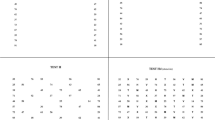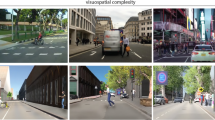Abstract
Individuals who do not fulfill required visual field standards have their driving license withdrawn in Sweden. However, understanding of the ability to compensate for this loss is limited. This study aimed to determine if reaction time and cognitive performance are important for safe driving in visual field loss (VFL) individuals. Visually demanding reaction time tasks of different complexity, for example, can help one understand why some VFL individuals drive as safely as normally sighted individuals. Twenty VFL individuals and 83 normally sighted individuals participated in a driving simulator experiment and an additional test battery. The driving task categorized VFL participants into two subgroups: passed or failed. Three reaction time tasks, four cognitive tests, and two meta-cognitive scales were completed. The passed VFL subgroup was faster than the failed subgroup in the context-dependent reaction time task and slower in the context-independent reaction time task. The passed subgroup performed equally well, or less well, on the cognitive tasks compared to the failed subgroup. The VFL participants performed less well than the normally sighted individuals on most cognitive tasks. However, VFL participants did not reflect on their driving ability (in meta-cognitive scales) in the same way as normally sighted individuals. There appear to be VFL subgroups in terms of ability to drive safely. Reaction time is important, but context dependent. Cognitive context-independent tests appear unrelated to driving test outcome for VFL individuals. The problems with context-independent testing of perceptual, cognitive, and meta-cognitive abilities when predicting safe driving capabilities are discussed.
Similar content being viewed by others
References
Andersson J, Peters B (2016) Simulator-based test method: assessment of driving ability in individuals with visual field loss [in Swedish]. Swedish National Road and Transport Research Institute, Linköping
Anstey KJ, Wood J, Lord S, Walker JG (2005) Cognitive, sensory, and physical factors enabling driving safety in older adults. Clin Psychol Rev 25:45–65
Baddeley AD, Hitch G (1974) Working memory. In: Bower GA (ed) The psychology of learning and motivation. London Academic Press, London, pp 47–89
Bhorade AM, Yom VH, Barco P, Wilson B, Gordon M, Carr D (2016) On-road driving performance with bilateral moderate and advanced glaucoma. Am J Ophthalmol 166:43–51
Blane A (2016) Through the looking glass: a review of the literature investigating the impact of glaucoma on crash risk, driving performance, and driver self-regulation in older drivers. J Glaucoma 25:113–121
Blane A, Falkmer T, Lee HC, Dukic Willstrand T (2018) Investigating cognitive ability and self-reported driving performance of post-stroke adults in a driving simulator. Top Stroke Rehabil 25:44–53
Boot WR, Stothart C, Charness N (2014) Improving the safety of aging road users: a mini-review. Gerontology 60:90–96
Bowers AR (2016) Driving with homonymous visual field loss: a review of the literature. Clin Exp Optom 99:402–418
Bowers AR, Ananyev E, Mandel AJ, Goldstein RB, Peli E (2014) Driving with hemianopia IV. Head scanning and detection at intersections in a simulator. Invest Ophthalmol Vis Sci 55:1540–1548
Bro T, Lindblom B (2018) Strain out a gnat and swallow a camel?—Vision and driving in the Nordic countries. Acta Ophthalmol 96:623–630
Brooke MM, Questad KA, Patterson DR, Valois TA (1992) Driving evaluation after traumatic brain injury. Am J Phys Med Rehabil 71:177–182
Coeckelbergh TRM, Brouwer WH, Cornelissen FW, Van Wolffelaar P, Kooijman AC (2002) The effect of visual field defects on driving performance: a driving simulator study. Arch Ophthalmol 120:1509–1516
Concetta FA, Peli E, Bowers AR (2013) Driving with hemianopia III. Detection of stationary and approaching pedestrians in a simulator. Invest Ophthalmol Vis Sci 55:368–374
de Vries SM, Heutink J, Melis-Dankers BJM, Vrijling ACL, Cornelissen FW, Tucha O (2018) Screening of visual perceptual disorders following acquired brain injury: a Delphi study. Appl Neuropsychol Adult 25:197–209
Endsley MR (1995) Toward a theory of situation awareness in dynamic systems. Hum Factors 37:32–64
Hardiess G, Hansmann-Roth S, Mallet HA (2013) Gaze movements and spatial working memory in collision avoidance: a traffic intersection task. Front Behav Neurosci 7:62
Herbert NC, Thyer NJ, Isherwood SJ, Merat N (2016) The effect of auditory distraction on the useful field of view in hearing impaired individuals and its implications for driving. Cogn Technol Work 18:393–402
Howard C, Rowe FJ (2018) Adaptation to poststroke visual field loss: a systematic review. Brain Behav 8:e01041
Kasneci E, Sippel K, Aehling K, Heister M, Rosenstiel W, Schiefer U, Papageorgiou E (2014) Driving with binocular visual field loss? A study on a supervised on-road parcours with simultaneous eye and head tracking. PLoS One 9:e87470
Keay L, Munoz B, Turano KA, Hassan SE, Munro SA, Duncan DD, Baldwin K, Jasti S, Gower EW, West SK (2009) Visual and cognitive deficits predict stopping or restricting driving: the Salisbury Eye Evaluation Driving Study (SEEDS). Invest Ophthalmol Vis Sci 50:107–113
Kubler TC, Kansneci E, Rosenstiel W, Scheifer U, Nagel K, Papageorgiou E (2014) Stress-indicators and explanatory gaze for the analysis of hazard perception in patients with visual field loss. Transport Res Part F 24:231–243
Kubler TC, Kansneci E, Rosenstiel W, Heister M, Aehling K, Nagel K, Scheifer U, Papageorgiou E (2015) Driving with glaucoma: task performance and gaze movements. Optom Vis Sci 92:1037–1046
Lajunen T, Summala H (1995) Driving experience, personality, and skill and safety-motive dimensions in drivers’ self-assessments. Pers Individ Dif 19:307–318
Laureshyn A, Svensson Å, Hydén C (2010) Evaluation of traffic safety, based on micro-level behavioural data: theoretical framework and first implementation. Accid Anal Prev 42:1637–1646
Leat SJ, Lovie-Kitchin JE (2008) Visual function, visual attention, and mobility performance in low vision. Optom Vis Sci 85:1049–1056
Lindblom B (2011) Visibility requirements for driving licenses [in Swedish]. Swedish Transport Agency, Gothenburg
Mamdoohi AR, Zavareh MF, Hydén C, Nordfjærn T (2014) Comparative analysis of safety performance indicators based on inductive loop detector data. Promet Traffic Traffico 26:139–149
McGwin G Jr, Huisingh C, Jain SG, Girkin CA, Owsley C (2015) Binocular visual field impairment in glaucoma and at-fault motor vehicle collisions. J Glaucoma 24:138–143
McKnight AJ, McKnight AS (1999) Multivariate analysis of age-related driver ability and performance deficits. Accid Anal Prev 31:445–454
Mishra S (2016) Exploring cognitive spare capacity: executive processing of degraded speech. Dissertation, Linköping University, Linköping
Nordmark S, Jansson H, Palmkvist G, Sehammar H (2004) “The new VTI driving simulator—multi purpose moving base with high performance linear motion”. Driving Simulation Conference, Paris
Nyberg J, Strandberg T, Berg H-Y, Aretun Å (2019) Welfare consequences for individuals whose driving licenses are withdrawn due to visual field loss: a Swedish example. J Transp Health 14:100591
Owsley C, Jr Gerald M (2010) Vision and driving. Vision Res 50:2348–2361
Özkan T, Lajunen T (2005) Multidimensional traffic locus of control scale (T-LOC): factor structure and relationship to risky driving. Pers Individ Dif 38:533–545. https://doi.org/10.1016/j.paid.2004.05.007
Papageorgiou E, Hardiess G, Ackermann H, Wiethoelter H, Dietz K, Mallot H, Schiefer U (2012) Collision avoidance in persons with homonymous visual field defects under virtual reality conditions. Vision Res 52:20–30
Parker WT, McGwin G Jr, Wood JM, Elgin J, Vaphiades MS, Kline LB, Owsley C (2011) Self-reported driving difficulty by persons with hemianopia and quadrantanopia. Curr Eye Res 36:270–277
Prado Vega R, van Leeuwen PM, Rendón Vélez E, Lemij HG, de Winter JCF (2013) Obstacle avoidance, visual detection performance, and eye-scanning behavior of glaucoma patients in a driving simulator: a preliminary study. PLoS One 8:e77294. https://doi.org/10.1371/journal.pone.0077294
Simon JR (1969) Reactions towards the source of stimulation. J Exp Psychol 81:174–176
Smith M, Mole CD, Kountouriotis GK, Chisholm C, Bhakta B, Wilkie RM (2015) Driving with homonymous visual field loss: does visual search performance predict hazard detection? Br J Occup Ther 78:85–95
Ungewiss J, Kübler T, Sippel K, Aehling K, Heister M, Rosenstiel W, Kasneci E, Papageorgiou E (2018) Agreement of driving simulator and on-road driving performance in patients with binocular visual field loss. Graefe’s Arch Clin Exp Ophthalmol 256:2429–2435
Wood JM (2002) Age and visual impairment decrease driving performance as measured on a closed-road circuit. Hum Factors 44:482–494
Wood J, Black AA (2016) Ocular disease and driving. Clin Exp Optom 99:395–401
Wood J, Black AA, Mallon K, Thomas T, Owsley C (2016a) Glaucoma and driving: on-road driving characteristics. PLoS One 11:e0158318
Wood G, Hartley G, Furley PA, Wilson MR (2016b) Working memory capacity, visual attention and hazard perception in driving. J App Res Mem Cogn 5:454–462
Young Kwon M, Huisingh C, Rhodes LA, McGwin G, Wood JM, Owsley C (2016) Association between glaucoma and at-fault motor vehicle collision involvement in older drivers: a population-based study. Ophthalmology 123:109–116
Acknowledgements
Open access funding provided by Swedish National Road and Transport Research Institute (VTI).
Author information
Authors and Affiliations
Corresponding author
Additional information
Publisher's Note
Springer Nature remains neutral with regard to jurisdictional claims in published maps and institutional affiliations.
Rights and permissions
About this article
Cite this article
Andersson, J., Peters, B. The importance of reaction time, cognition, and meta-cognition abilities for drivers with visual deficits. Cogn Tech Work 22, 787–800 (2020). https://doi.org/10.1007/s10111-019-00619-7
Received:
Accepted:
Published:
Issue Date:
DOI: https://doi.org/10.1007/s10111-019-00619-7




